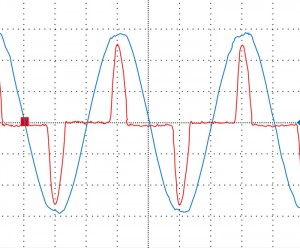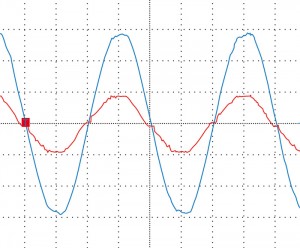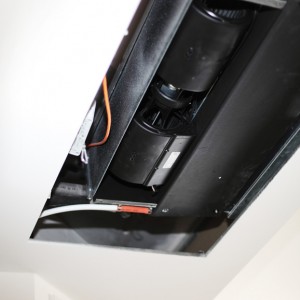Selecting a suitable fan is no easy task for the producers of fan coils. Besides having the required power, running as quietly as possible and fitting into the housing, the fan drive that is used needs to operate in a way that matches the application’s requirements, since the drive has a critical effect on energy consumption and thus on operating costs. Depending on the application, other fan characteristics can also be important. For example, when several EC fans are operated in parallel, active power factor correction (PFC) prevents objectionable harmonics and the relevant requirements of EN 61000-3-2 can then be met without additional engineering effort.
Fan coils used in offices, hotel rooms or municipal facilities are often operated in parallel connection. This method of connecting the EC fans that are usually used in these devices for reasons of energy efficiency and noise reduction does not fully exclude effects on the grid. The pulsed input current of EC fans gives rise to current harmonics, which strain the supply grid and can cause increased losses due to reactive power. In parallel operation of multiple EC fans, this can cause the permitted thresholds according to EN 61000-3-2 to be exceeded and can have a negative effect on other devices in the system network.
Expensive but avoidable interference suppression measures
A remedy for this problem can be expensive. The operators need to ensure sufficient reactive power compensation and provide central interference filters, which of course take up space. And space is often in short supply. Since the harmonics also affect the internal supply network, consideration must also be given to adequate cable cross sections. When retrofitting fan coil units, new wiring may even be necessary. However, installing it usually proves difficult or even impossible in practice for structural and economic reasons. Of course an external interference filter could be connected to each fan, but such devices are costly and may not exactly match their fans’ motors and are thus only conditionally adequate.

Figure 1: The EC centrifugal fans are available in single, twin and triple configurations for air performances of up to 2,500 m³/h in the power range up to 250 W.
Now planners and operators can save themselves all this trouble since the motor and fan specialist ebm-papst Mulfingen has addressed this issue. Now its EC centrifugal fans (Figure 1), which are specially designed for use in fan coil units, are now also available with active PFC. This integrated power factor correction converts the pulsed input current of the EC motors into a sinusoidal current. In the second step, the current is shifted so that it is in phase with the voltage. This significantly reduces the harmonic content of the input current. The effective value of the input current is also minimized and it is possible in many applications to select a smaller cross-section for the fan supply lines. Figs. 2 and 3 show the same combination of motor and fan impeller at the same operating point and with identically adjusted air performance with and without active PFC. Problems with harmonics and reactive power losses are no longer cause for worry thanks to the integrated power factor correction, which is perfectly matched to the motors. The requirements of EN 61000-3-2 are fulfilled with no additional measures.
Energy-saving and quiet
But the EC centrifugal fans have more to offer. For instance, fan coils are generally operated for extended periods, so high efficiency levels gain particular significance. The EC fans are also effective in this regard. They work with high efficiencies. Since their GreenTech EC motors consume up to 70% less energy than conventional AC motors, they have a noticable effect on operating costs (Figure 4).

Figure 4: The investment in GreenTech EC technology is already amortized in less than two years thanks to its low energy consumption. Maintenance-free operation and long service life reduce life cycle costs even further.
High efficiency also means that less heat is dissipated. When the fan coil is in cooling mode, dissipated heat would mean that additional cooling output is required. In addition, the low motor temperatures have a beneficial effect on the service life of the ball bearings. However, modern EC technology does not provide savings only during full-load operation. It is exactly when operating under partial load that EC motors lose much less of their efficiency. This means that the energy savings become noticeable even when the fans are operated in low speed ranges, and operators quickly notice the benefits on the bottom line. The EC centrifugal fans are available in single, twin and triple configurations for air performances of up to 2,500 m³/h in the power range up to 250 W. All versions are specially designed for low-noise operation; they are very compact and can be easily installed as a plug & play solution. The fan is mounted on its exhaust flange and connected using a plug system. The plastics used are light, yet durable and sound-absorbing; this combined with aerodynamic design allows the fans to operate at very low noise levels.
For different needs
Since users should always pay only for the technology they need, in addition to the standard version that can optionally be equipped with power factor correction, there is also a basic version which also offers all the benefits of GreenTech EC technology and is suitable for applications in which a PWM signal is sufficient for infinitely variable speed control. There are now efficient EC centrifugal fans available for use in various fan coil applications; they can also be used for other applications with similar requirements (Figure 5). The air curtains in the entrance areas of department stores or factory halls are an example.




Leave a comment